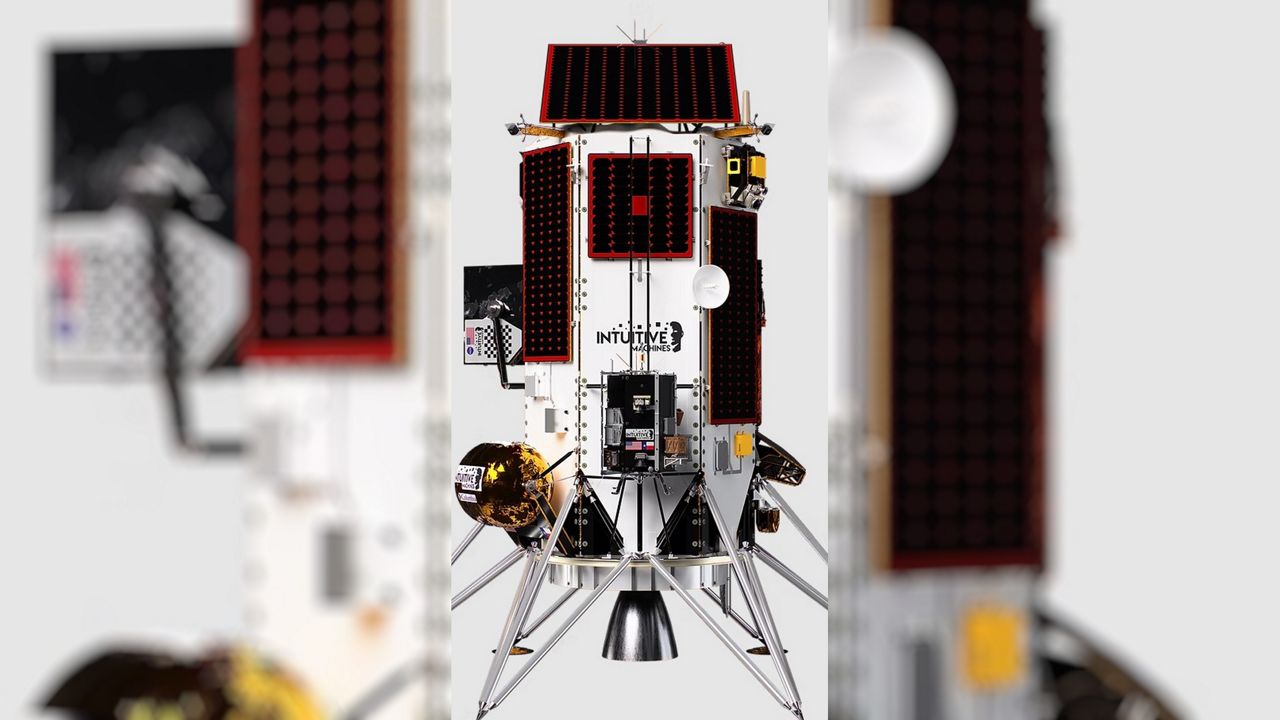KENNEDY SPACE CENTER — NASA showcased the next lunar lander from Intuitive Machines on Friday afternoon, which is the same company to be the first commercial business to land on the moon.
The next moon mission will demonstrate the technologies being used to hunt for different forms of water.
What You Need To Know
- The IM-2 mission will search for different forms of water and run experiments on new technologies
- SpaceX’s Falcon-9 rocket is set to take off with the IM-2 mission from Launch Complex 39A from the Kennedy Space Center on Wednesday, Feb. 26
- This will be a 10-day mission if it launches as scheduled
- Get more space coverage here ▶
- 🔻Scroll down to learn about the different technology and rovers for the mission🔻
During the teleconference, NASA officials spoke about the next mission to head to the moon.
Known as the IM-2 mission, it is part of NASA's Commercial Lunar Payload Services (CLPS) program. The program allows NASA to work with several companies to deliver technology and experiments to the moon’s surface.
SpaceX’s Falcon-9 rocket is set to take off with the IM-2 mission from Launch Complex 39A from the Kennedy Space Center on Wednesday, Feb. 26.
The Houston-based company’s Nova-C lunar lander is named after the Greek goddess Athena who was best known for her wisdom and warfare.
But this Athena is 14 feet (4.3 meters) tall and will be carrying a number of experiments and tools, including NASA’s special drill, to about 100 miles (161 kilometers) to the moon’s South Pole at the location known as Mons Mouton.
It is hoped that it will land on the moon on Thursday, March 6, for a 10-day mission. During which time, a solar eclipse will also occur and additional data will be collected.
“We all know that landing on the moon is hard and NASA's instruments and science experiments will be delivered to a part of the lunar surface that humans have not yet explored. Mons Mouton, a plateau near the lunar South Pole, is a scientifically strategic landing area. You can think of it as the goldilocks zone for sunlight that can power a roughly 10-day mission while maintaining a clear view to Earth,” said NASA’s Associate Administrator of Science Mission Directorate Nicky Fox.
Fox said the IM-2 will help with the Artemis III moon mission, which will see the return of humans to Earth’s lunar sister.
“This is really a key part in our preparation to send astronauts safely back to the moon and soon onto Mars,” Fox said of the IM-2 mission.
One of the major objectives for the mission is to use NASA’s Regolith and Ice Drill for Exploring New Terrain (TRIDENT) that will dig about 3 feet (1 meter) into the lunar ground and deposit samples on the surface for testing. The Mass Spectrometer observing lunar operations (MSolo) will then be used detect any possible volatiles or gases.
Fox said that the volatiles could be trapped water ice, particles from an early atmosphere of the moon or gases.
This experiment is known as Polar Resources Ice Mining Experiment.
1 (PRIME-1). The principal investigator of the PRIME-1 mission, Dr. Jacqueline Quinn, explained that TRIDENT will drill down at nearly 4 inches (10 centimeters) at a time. The regolith, or lunar rock and soil, will be deposited onto the surface where it will be studied and any volatile data to be collected.
But Athena and the Falcon 9 rocket will be carrying a lot more payloads from other companies and NASA.
The IM-2's Micro Nova Hopper is designed to make short flights or hops, where it will eventually explore a small permanently shadowed crater about a quarter of a mile from the landing site. It is hoped to discover water ice.
During Friday’s teleconference, Senior Vice President of space systems at Intuitive Machines Trent Martin said the hopper will first hop 65 feet (20 meters) into the sky and land 65 meters away from Athena. The second hop will be 164 feet (50 meters), with the third hop being the largest at 328 feet (100 meters).
It will land in a permanently shadowed crater, where it will survey and collect any data. But if communications are lost, the little hopper has other ways of getting out of the crater, he said.
“If we do not (have communications) however, the vehicle will either go off of a timer after 45 minutes, it will hop back out on its own or it will go off of a temperature setting, so if the temperatures reach a minimum, the hopper will hop back out on its own,” he said.
The history of IM-1
The IM-1 mission in February 2024 was deemed a “successful mission” but it had the bad luck of having one of the NOVA-C lunar lander’s legs dig into the moon’s soil as it was coming in for the landing, which resulted in it tipping over.
Martin revealed to Spectrum News how the lunar lander, called Odysseus, tipped over and the extend of its damage.
“There was an issue with the laser altimeter that we used during the final operation just before landing that would have told us exactly how close we were to the surface. Instead of using the laser altimeter, we were actually just using the camera systems that were on board the spacecraft and that meant that we landed harder than we intended to land. Because we did, we ended up breaking off a leg and falling over to our side,” he said.
After the IM-1 mission, Martin said engineers went over what went right and what went wrong and identified 85 things that needed to be looked at and worked on.
“We have definitely fixed some of the issues that we had on our first mission,” he said.
But all of the payloads were in operating order. The lunar lander and its payloads were able to collect and transmit the data collected, which made the mission a successful one, Martin said.
Intuitive Machines made history by being the first private company to land on the moon.
The mission only lasted six days before the extreme cold temperatures of the lunar night froze Odysseus.



